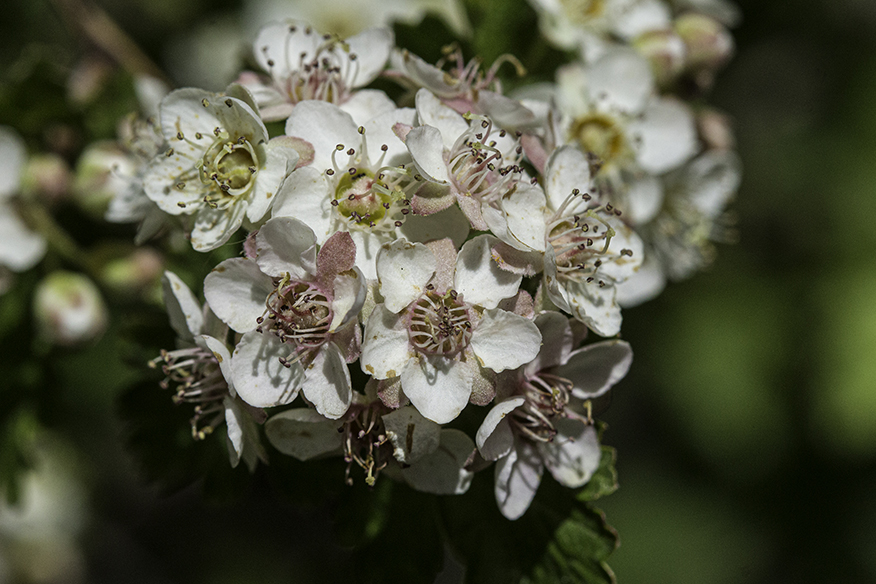While bloomng whildflowers may be scare in White Rock or even on the trails in Los Alamos, the high country is just getting started. This week I visited the San Pedro Parks, the Valles Caldera, and Cañada Bonita and found almost 100 species in bloom.
In the San Pedro Parks, three species of Pedicularis (louseworts) were scattered through the dense woods and open, moist meadows. Because it is three or four feet tall, Fernleaf Lousewort (Pedicularis procera) is the easiest to find (it’s also along the Cañada Bonita Trail). The leaves look just like fern fronds, but when the flowers appear there is no mistaking it: yellowish tubes streaked with fine red lines, ending with a hooked nose. Sickletop Lousewort (Pedicularis racemosa) is a smaller plant with triangular, sharp-toothed leaves and small white flowers with long, sickle-shaped beaks. It is found in the forested areas of the Parks. I spotted a few Elephantheads, too (Pedicularis groenlandica) in the moist areas of the Vallecito Damien and along Clear Creek. The hot pink flowers have a long, upcurved beak and the flowers really do look like elephant heads.



One of my summer favorites is Orange Skyflower (Pyrrocoma crocea), found in the Parks, the Valles Caldera, and along the Cañada Bonita Trail (in a week or two).


Gunnison’s Mariposa Lily (Calochortus gunnisonii) is all over the Cañada Bonita meadow and can be found in the Valles Caldera.

A nice surprise in the Valles Caldera was a patch of White-throated Penstemon (Penstemon inflatus), and endemic species often said to be found only in the Sandia Mountains but this is the third location I’ve found in the Jemez.

Social distancing? Nineteen miles of trail for these blooms, 11 other trail users. Get out there!
Plant List for Cañada Bonita Trail, July 3, 2020
| Family | Genus | Species | JMP common name |
|---|---|---|---|
| Amaryllidaceae | Allium | cernuum | nodding onion |
| Apiaceae | Pseudocymopterus | montanus | mountain parsley |
| Asteraceae | Achillea | millefolium | yarrow |
| Asteraceae | Erigeron | divergens | spreading fleabane |
| Asteraceae | Erigeron | eximius | spruce-fir fleabane |
| Asteraceae | Erigeron | flagellaris | trailing fleabane |
| Asteraceae | Erigeron | formosissimus | most beautiful fleabane |
| Asteraceae | Erigeron | subtrinervis | three-nerved fleabane |
| Asteraceae | Helianthella | quinquenervis | nodding sunflower |
| Asteraceae | Hymenoxys | hoopesii | owl’s-claws |
| Asteraceae | Rudbeckia | hirta | black-eyed Susan |
| Asteraceae | Taraxacum | officinale | common dandelion |
| Asteraceae | Tragopogon | dubius | yellow salsify |
| Brassicaceae | Draba | aurea | golden draba |
| Brassicaceae | Erysimum | capitatum | western wallflower |
| Campanulaceae | Campanula | rotundifolia | harebell |
| Caryophyllaceae | Eremogone | fendleri | Fendler’s sandwort |
| Fabaceae | Melilotus | officinalis | yellow sweetclover |
| Fabaceae | Trifolium | hybrdium | Alsike Clover |
| Fabaceae | Trifolium | repens | white clover |
| Fabaceae | Trifolium | pratense | red clover |
| Fabaceae | Vicia | americana | American vetch |
| Geraniaceae | Geranium | caespitosum | purple geranium |
| Geraniaceae | Geranium | richardsonii | Richardson’s geranium |
| Liliaceae | Calochortus | gunnisonii | Gunnison’s mariposa lily |
| Linaceae | Linum | lewisii | western blue flax |
| Onagraceae | Chamerion | angustifolium | fireweed |
| Orobanchaceae | Castilleja | nelsonii | Southern Mountain Paintbrush |
| Orobanchaceae | Castilleja | miniata | scarlet paintbrush |
| Orobanchaceae | Pedicularis | procera | fern-leafed lousewort |
| Plantaginaceae | Penstemon | strictus | Rocky Mountain penstemon |
| Plantaginaceae | Penstemon | whippleanus | Whipple’s penstemon |
| Polemoniaceae | Ipomopsis | aggregata | skyrocket |
| Ranunculaceae | Delphinium | sapellonis | Sapello Canyon larkspur |
| Rosaceae | Dasiphora | fruticosa | shrub potentilla |
| Rosaceae | Physocarpus | monogynus | ninebark |
| Rosaceae | Potentilla | pulcherrima | beautiful cinquefoil |
| Rosaceae | Rubus | parviflorus | thimbleberry |
| Rubiaceae | Galium | aparine | goosegrass |
| Rubiaceae | Galium | boreale | northern bedstraw |









































































